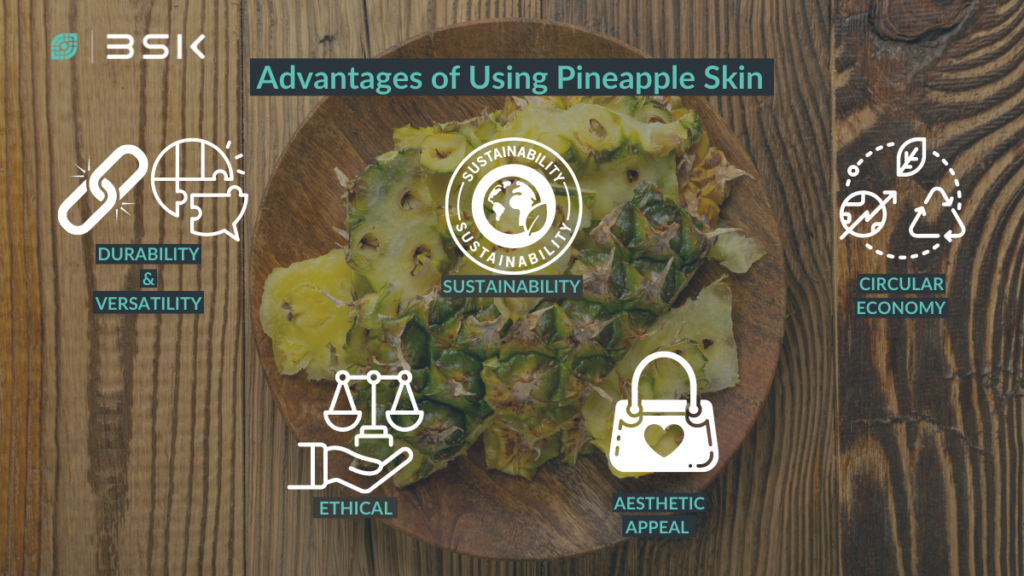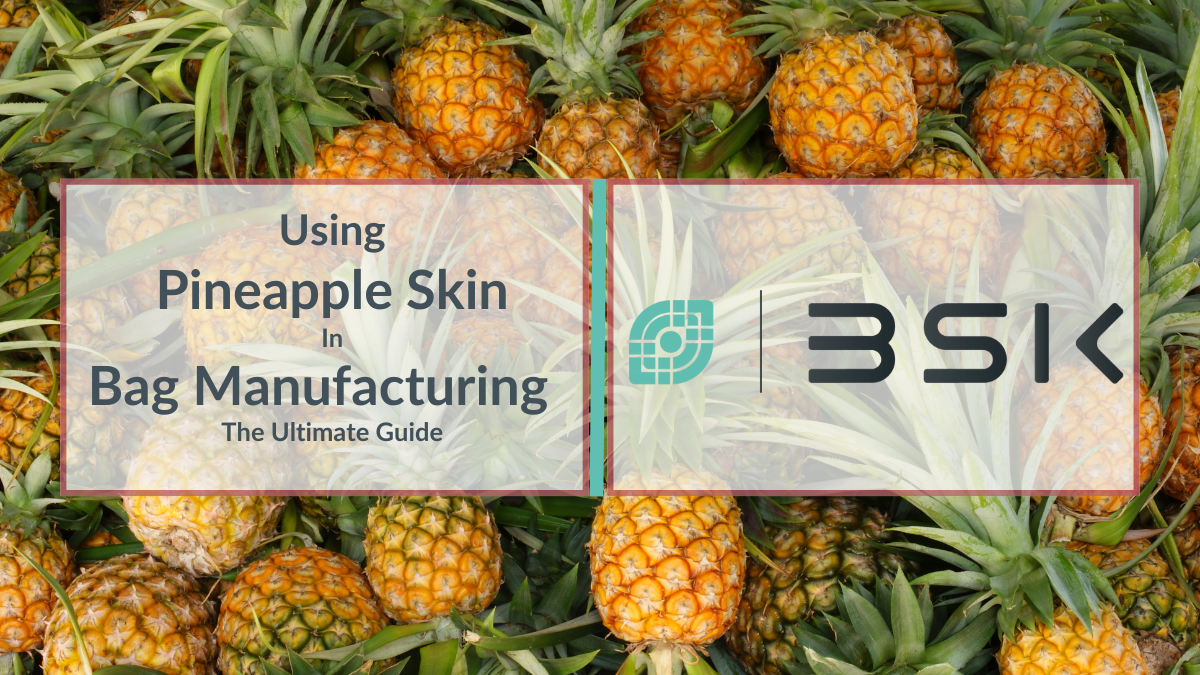They are using pineapple skin in bags! Imagine a world where pineapples do more than tickle your taste buds. They’re revolutionizing the bag and fashion manufacturing industry! That’s right, since its inception in 2015, pineapple skin has started an incredible, eco-friendly trend in the vegan leather world.
Designers and manufacturers are excited as they explore this fantastic alternative to traditional leather. This isn’t just a fleeting trend; it’s a movement. People everywhere are clamoring for vegan leather options, and the pineapple is also at the front of the charge. It’s an exhilarating time to witness this shift, especially with the vegan leather market booming! Can you believe it was valued at USD 73.38 billion in 2023? And brace yourself; it’s projected to soar to a staggering USD 139.02 billion by 2030. The future of fashion is here, and it’s vegan, sustainable, and irresistibly chic, all thanks to the humble pineapple!
What is Pineapple Skin?
Also known as Piñatex is a revolutionary vegan leather made from pineapple leaves, a by-product. Developed by Ananas Anam under the guidance of Dr. Carmen Hijosa, Piñatex emerges as an eco-friendly and sustainable alternative to traditional animal and petroleum-based faux leathers.
Key Features
Piñatex reduces greenhouse gas emissions by repurposing discarded materials for eco-friendly leather alternatives, offering pineapple farmers an extra income source and helping cut CO2 emissions by preventing pineapple waste burning.
Piñatex, with an 80% biodegradability rate, is crafted from pineapple leaf and vegetable-based plastic, though its biodegradability is hampered by a petroleum resin coating, with progress being made towards a bio-based alternative. Its range of textures, including smooth, grainy, and metallic finishes, enhances its versatility in fashion and design. Piñatex is durable, making it ideal for bags and accessories, appealing to both luxury brands and everyday use. Its adoption by major fashion brands and vegan designers highlights its appeal as a sustainable and ethical fashion choice.
Piñatex represents a significant advancement in the pursuit of eco-friendly materials, promising a future where fashion and sustainability go hand in hand.

Advantages of Using Pineapple Skin
Sustainability and Environmental Impact
Talk about a tropical treasure! Pineapple skin has significant benefits in terms of sustainability and its minimal environmental footprint. It is a byproduct of the pineapple harvest. It is crafted from pineapple leaves, which do not require additional land, water, fertilizer, or pesticides to produce. This promotes a circular economy and greatly reduces the environmental impact traditionally associated with bag production. It represents a step towards a fashion industry that highly values the well-being of our planet.
Durability and Versatility
The skin of a pineapple is highly valued for its strength and adaptability, making it an excellent material for a variety of bags. It is suitable for everyday use, luxury handbags, and outdoor gear due to its resistance to stretching and abrasion, ensuring that products from it last a long time and can withstand wear and tear. Its lightweight nature also makes it ideal for creating comfortable products for use in various conditions.
Aesthetic Appeal
Bringing a touch of tropical flair to everything from sleek briefcases to bohemian handbags. The material is known for its distinctive texture and sophisticated appearance, which rivals traditional leather without ethical concerns. It offers a range of colors and finishes, giving designers the freedom to innovate and appeal to diverse fashion tastes, from professional briefcases to chic tote bags, all while maintaining eco-friendly values.
Ethical Production Standards
Adhering to high ethical standards, the production of pineapple skin-based materials avoids the use of animal products and reduces dependence on fossil fuels. This cruelty-free characteristic is especially appealing to vegan consumers and those mindful of animal welfare. Moreover, the manufacturing process benefits farming communities by providing supplementary income and advocating for ethical labor practices.
Limitations
Durability
Every rose has its thorn, and even our beloved Piñatex has a few prickly points. Concerns exist around Piñatex’s longevity compared to traditional leather. While robust, Piñatex may not hold up as well under frequent use, showing quicker signs of wear and reducing the lifespan of products made from it.
Cost
Producing Piñatex is labor-intensive and involves processes like harvesting pineapple leaves, resulting in higher costs compared to synthetic leathers. This could make Piñatex-based products more expensive.
Environmental Impact
Piñatex is beneficial in reducing waste and avoiding animal products, but its manufacturing is not without environmental costs, including energy consumption and potential chemical use.
Maintenance
The care required for Piñatex products may be more specialized than for other materials, potentially deterring some customers.
Production and Manufacturing
The manufacturing processes involved in working with Piñatex, a material derived from pineapple leaf fibers, are innovative and environmentally friendly. The production begins with extracting fibers from pineapple leaves, requiring specialized decortication machinery. These fibers are then transformed into a non-woven Piñafelt mesh through felting. This base material mimics the texture and durability of traditional leather. It is dyed with eco-friendly dyes and coated with a water-based polyurethane resin to enhance its durability, aesthetics, and water resistance. The efficient processing and assembling of bags from Piñatex require special equipment and techniques. Precision cutting tools are employed to minimize waste, taking full advantage of the material’s roll form.
The machinery and processes align with sustainable production principles, ensuring the fibers interlock properly to create a robust fabric. Manufacturers may also need to recalibrate sewing machines and select appropriate needles or threads to prevent tearing and ensure the product’s longevity. The design, cutting, stitching, and finishing of Piñatex products necessitate specific considerations due to the material’s unique texture and composition. The material’s variability in thickness and texture affects the design process, encouraging a flexible and innovative approach to pattern-making and assembling. Sharp tools and needles are essential for cutting and stitching to prevent tearing. Furthermore, finishing techniques for Piñatex differ from those used for conventional leather goods, as the material absorbs dyes and treatments differently. This necessitates special eco-friendly coatings to maintain the material’s breathability and natural appearance while enhancing its durability and water resistance.
Sustainability and Environmental Impact of Pineapple Skin
The sustainability aspects of Piñatex are truly a beacon in material innovation, particularly in the fashion and textiles sector. This innovative material stands out for its use of renewable resources, which is evident in its foundation of pineapple leaf fibers. These fibers are a byproduct of the pineapple harvest, which prevents waste and turns it into wealth. This approach does not just benefit the environment by reducing waste. It offers a new income stream for farmers, embodying the essence of a waste-to-wealth philosophy. Remarkably, Piñatex stands out since it is 80% biodegradable, demonstrating its dedication to minimizing the fashion industry’s environmental impact.
The Sustainable Journey
Aside from its impressive biodegradability, Piñatex requires significantly less water and energy than conventional leather production and many synthetic alternatives. This reduction is crucial in minimizing the material’s overall environmental impact from its production phase to the end of its lifecycle. Furthermore, Piñatex’s production journey is laden with eco-friendly practices to shrink its ecological footprint. The brand is on a continuous quest for certifications that mirror its dedication to sustainability, including efforts to adopt a bio-based coating for full biodegradability and achieve notable certifications like GOTS for its dyes.
The alignment of Piñatex with contemporary environmental concerns stands out clearly. It not only meets but also surpasses the expectations of an increasingly ecologically aware consumer base in many areas. It represents a move towards circular economy models in the industry, focusing on resource efficiency and waste minimization. Moreover, notable eco-friendly and ethical certifications acknowledge Piñatex. It has PETA approval and registration with the Vegan Society, highlighting its cruelty-free benefit. Furthermore, it sets itself apart by becoming the first branded textile in the UK to earn Certified B Corporation status. This achievement underlines Piñatex’s commitment to high social and environmental performance standards, along with transparency and accountability.
In addition to its commendable environmental footprint. Piñatex heralds a new dawn in the materials sector, shifting away from reliance on animal leather and petroleum-based materials and towards more sustainable, eco-friendly alternatives. Through its innovative use of agricultural byproducts, Piñatex is not just a material; it’s a movement towards more responsible, sustainable, and environmentally conscious manufacturing practices.
Conclusion
Exploring the use of pineapple skin for fashion reveals its role as a sustainable alternative to leather. Since 2015, Piñatex has offered an eco-friendly alternative to leather with their innovative material.
The essence of Piñatex as a groundbreaking material lies in its sustainability. This method uses pineapple leaves, enhancing sustainability, reducing waste, and offering farmers an additional income source. Beyond the environmental perks, Piñatex earns acclaim for its durability, versatility, and aesthetic appeal. Captivating the fashion world, it mimics traditional leather ethically, showcasing its position in eco-friendly innovation.
However, its journey towards perfection encounters a hitch – the current limitation of its biodegradability due to a petroleum resin coating. Efforts are ongoing to transition to a bio-based coating, which promises to enhance its environmental credentials further.
The adoption of Piñatex by the fashion industry is a testament to its versatility. It serves an array of purposes, from luxurious designer items to daily essentials, courtesy of its various finishes and durability. Its low environmental impact, combined with ethical production standards, positions it as an exemplary material aimed at reducing the fashion industry’s carbon footprint and promoting animal welfare.
As we consider Piñatex for bag manufacturing, its compelling blend of sustainability, practicality, and aesthetic charm stands out. The material’s resilience and lightweight nature make it ideal for a broad spectrum of products, catering to both luxury and casual realms. It’s a call to designers and manufacturers to pivot towards a more sustainable, ethical, and versatile material choice. Promising a future where fashion and eco-consciousness walk hand in hand. Let this be a moment to reflect on our material choices and steer towards sustainable innovation in our creations.
